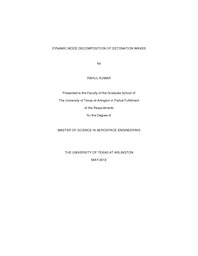
ATTENTION: The works hosted here are being migrated to a new repository that will consolidate resources, improve discoverability, and better show UTA's research impact on the global community. We will update authors as the migration progresses. Please see MavMatrix for more information.
Show simple item record
| dc.contributor.author | Kumar, Rahul | en_US |
| dc.date.accessioned | 2012-07-25T19:10:22Z | |
| dc.date.available | 2012-07-25T19:10:22Z | |
| dc.date.issued | 2012-07-25 | |
| dc.date.submitted | January 2012 | en_US |
| dc.identifier.other | DISS-11658 | en_US |
| dc.identifier.uri | http://hdl.handle.net/10106/11122 | |
| dc.description.abstract | Dynamic mode decomposition is applied to study the self-excited fluctuations supported by transversely unstable detonations. The focus of this study is on the effect of forcing on the limit cycle solutions. Using DMD, only the most coherent modes are analyzed. The most coherent modes in this case are the fundamental and the fourth harmonic. The analysis is based on the coherency of the self-excited detonation modes due to turbulence. Analysis reveals coherency is significantly affected with a turbulent Mach number greater than 0.3 and also the regions downstream of the shock are more affected by turbulence than the region just behind the shock. The effect of forcing is also analyzed in terms of the four fundamental energy modes: acoustic, kinetic, entropic and chemical. Results of the modal decomposition suggest that the near shock region is controlled by thermo-acoustic instability and a far field region dominated by convected turbulence. | en_US |
| dc.description.sponsorship | Massa, Luca | en_US |
| dc.language.iso | en | en_US |
| dc.publisher | Aerospace Engineering | en_US |
| dc.title | Dynamic Mode Decomposition Of Detonation Waves | en_US |
| dc.type | M.S. | en_US |
| dc.contributor.committeeChair | Massa, Luca | en_US |
| dc.degree.department | Aerospace Engineering | en_US |
| dc.degree.discipline | Aerospace Engineering | en_US |
| dc.degree.grantor | University of Texas at Arlington | en_US |
| dc.degree.level | masters | en_US |
| dc.degree.name | M.S. | en_US |
Files in this item
- Name:
- Kumar_uta_2502M_11658.pdf
- Size:
- 1.672Mb
- Format:
- PDF
This item appears in the following Collection(s)
Show simple item record


